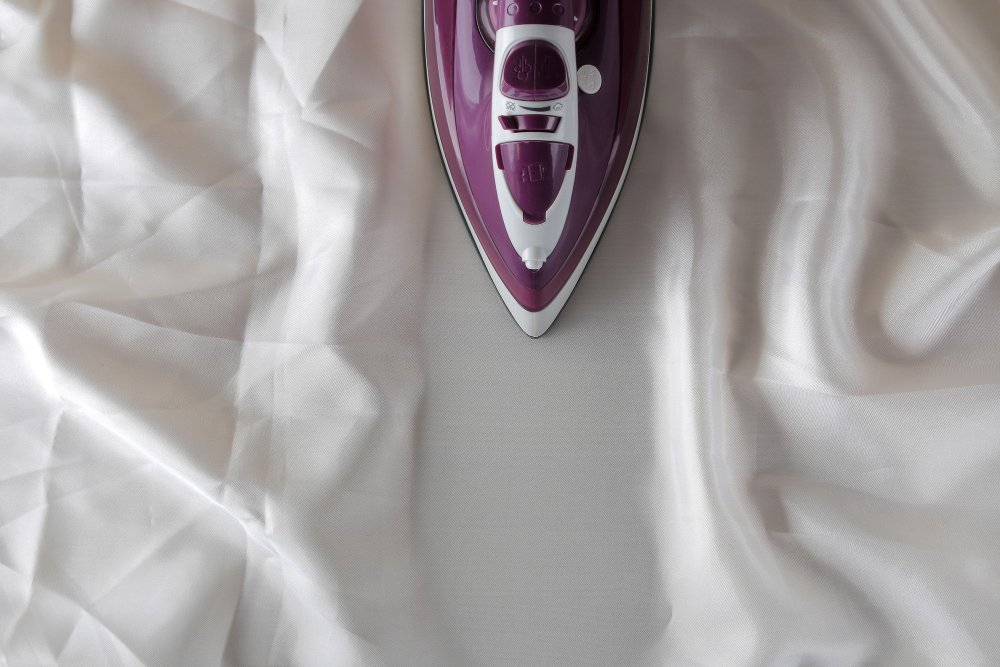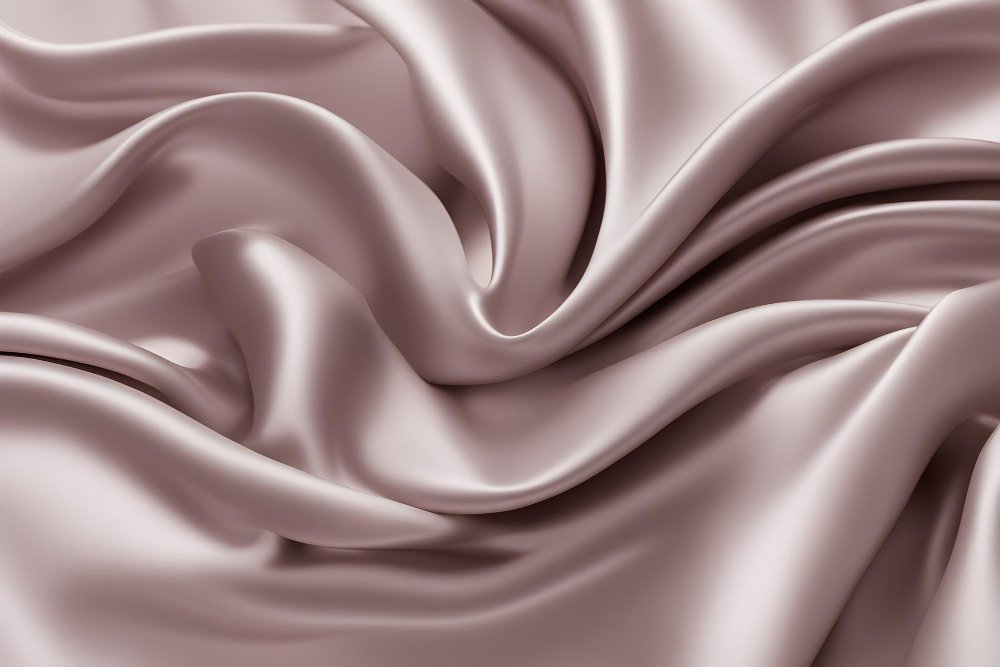Everything You Need to Know About Shantung Fabric, From History to Care Instructions
Table of Contents
- What is Shantung Fabric?
- History and Origins
- How Shantung Fabric is Made
- Types of Shantung Fabric
- Characteristics and Properties
- Shantung vs Other Fabrics
- The Tussah Silk Connection
- Sustainability and Environmental Impact
- Uses and Applications
- Care Instructions
- Buying Guide
- Frequently Asked Questions
- Conclusion
What is Shantung Fabric?

Shantung fabric is a plain weave silk known for its slightly rough, textured surface created by irregular slubs (thicker sections) in the yarn. Despite its subtle texture, many fabric experts consider it one of the finest silks available today. The fabric has a crisp feel and a soft sheen that catches the light beautifully.
What kind of fabric is shantung? Shantung is a natural silk fabric, traditionally made from wild silk fibers called tussah silk. However, modern versions also come in synthetic materials like polyester or in blended forms that combine silk with other fibers.
The main thing that sets Shantung apart from other silks is its slightly irregular, nubby texture. While habotai silk is smooth and chiffon is sheer, Shantung has a distinctive character that adds visual interest to any garment. The fabric is lighter than dupioni silk but has more body than crepe de chine.
Is shantung silk real silk? Yes, traditional Shantung is made from real silk fibers, specifically from tussah silk. However, you’ll also find synthetic versions made from polyester that mimic the look and feel of silk Shantung at a lower price point.
The Difference Between Silk and Shantung Silk
When people ask “what is the difference between silk and shantung silk,” they’re usually referring to the difference between smooth, cultivated mulberry silk and Shantung. Here’s the key difference:
- Standard Silk (Mulberry): Smooth, lustrous, made from domesticated silkworms that feed on mulberry leaves
- Shantung Silk: Textured with slubs, made from wild silk (tussah) that comes from silkworms feeding on oak and other leaves
This difference in the silkworm’s diet and environment creates the unique texture that Shantung is famous for. To learn more about different silk types, check out our complete guide to silk fabric.
History and Origins: From Shandong Province to Global Fashion

The Birthplace of Shantung
The name “Shantung” comes from Shandong Province (formerly romanized as “Shantung”) on China’s eastern coast. This region has been producing silk for at least 4,000 years, making it one of the oldest silk-producing areas in the world. The practice of sericulture (silk cultivation) has deep roots in Chinese history and culture.
What is Chinese silk fabric called? In China, this fabric is traditionally associated with the Liutuan weaving technique, an intangible cultural heritage of Shandong Province. The town of Liutuan was once considered the heart of the highest-quality Shantung production and served as a starting point of the modern Maritime Silk Road.
Shandong Province holds special cultural significance in China. It’s considered one of the holiest areas in the country, with deep roots in Taoist and Confucian spiritual traditions. This is also where China’s first ruler declared himself emperor over 2,000 years ago, adding to the region’s rich historical legacy.
Journey to the West
Shantung fabric made its way to Southeast Asia as early as 1842, contributing to the Maritime Silk Road’s expansion. However, it didn’t reach Western markets until the Renaissance period. Initially, smoother silk weaves were more popular in Europe and America, but Shantung’s unique texture gradually gained recognition. Today, museums like the Victoria & Albert Museum showcase historical silk textiles, including examples of early Shantung fabrics.
By the 1800s and 1900s, Shantung became associated with luxury in the West, particularly for summer day wear and accessories. It was considered an informal but high-end fabric, perfect for items like parasols, tennis dresses, and elegant summer clothing.
Is Chinese silk good quality? Yes, Chinese silk, particularly from regions like Shandong, is known for excellent quality. China still produces the majority of the world’s silk today, with Shandong continuing to be a major silk-producing region. Towns like Changyi remain active hubs for Shantung production.
How Shantung Fabric is Made
Understanding how Shantung is made helps explain its unique characteristics. The manufacturing process creates the fabric’s signature texture while maintaining its strength and beauty.
Step 1: Harvesting Silkworm Cocoons
The process begins with tussah silkworms, which are often called “wild” silkworms because they feed on oak, juniper, and other leaves (not just mulberry). These silkworms spin cocoons in their natural environment or in semi-wild conditions.
The cocoons are collected after the silkworms complete their transformation. Some ethical producers wait until the moth emerges naturally, creating what’s known as “peace silk” or “ahimsa silk,” though this is less common for traditional Shantung.
Step 2: Extracting the Silk Fibers
The cocoons are boiled in water to soften the sericin (a gum-like protein that holds the silk fibers together). Workers then carefully unravel the silk filaments from each cocoon. Because tussah silk comes from wild silkworms, the fibers are shorter and more irregular than cultivated silk, which contributes to Shantung’s textured appearance.
Step 3: Creating the Yarn
The silk filaments from multiple cocoons are twisted together to form yarn. For Shantung fabric, two types of yarns are created:
- Smooth yarns: These are rolled through machinery to create uniform threads, typically used as the warp (vertical threads)
- Slub yarns: These maintain their natural irregularities and thicker sections, usually serving as the weft (horizontal threads)
This combination of smooth and textured yarns creates Shantung’s characteristic appearance.
Step 4: Weaving the Fabric
Traditional Shantung was handwoven on small looms in village cottages. Today, most Shantung is machine-woven, though some artisan producers still use traditional methods. The fabric is woven in a simple plain weave pattern, where warp and weft threads cross over and under each other alternately.
The irregular weft yarns create the horizontal slubs that give Shantung its texture, while the smooth warp threads ensure the fabric maintains its structure and durability.
Step 5: Dyeing and Finishing
Shantung is often yarn-dyed, meaning the threads are colored before weaving. This creates rich, lasting colors. Some producers use plant-based dyes for a more eco-friendly approach.
After weaving, the fabric may undergo additional treatments like steaming or pressing to set the texture and improve the hand feel. Unlike some silks that are heavily processed, Shantung retains much of its natural character.
Types of Shantung Fabric
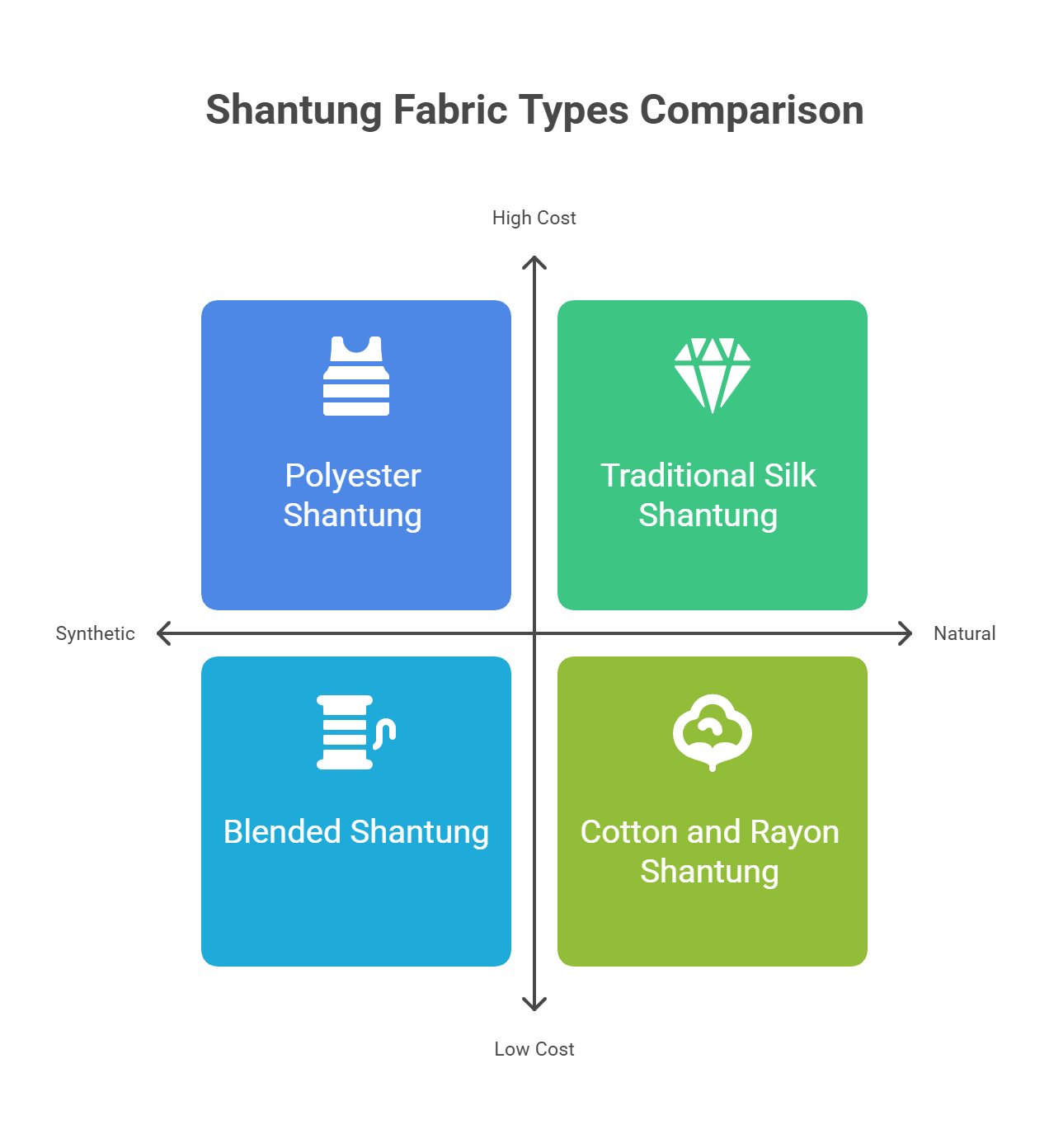
Not all Shantung fabrics are the same. Here’s a breakdown of the different types available in today’s market:
1. Traditional Silk Shantung
This is the original and most prized form of Shantung. Made from 100% tussah silk, it offers the best combination of texture, drape, sheen, and durability. Traditional silk Shantung is biodegradable and has that authentic natural feel that synthetic versions can’t match.
Best for: High-end wedding gowns, formal wear, luxury home decor
Price range: $$$$
2. Polyester Shantung
What is polyester shantung? This is a synthetic version made from polyester fibers designed to mimic the look of silk Shantung. While it can resemble silk Shantung in appearance, it lacks the breathability, natural sheen, and luxurious feel of real silk.
Polyester Shantung is more affordable and easier to care for than silk, making it popular for budget-friendly projects, costumes, and items that need frequent washing. However, it’s not biodegradable and doesn’t regulate temperature as well as natural silk.
Best for: Budget weddings, costumes, everyday home decor, craft projects
Price range: $
3. Blended Shantung
Blended Shantung combines silk with synthetic fibers (like polyester or rayon) or other natural fibers (like cotton). These blends aim to balance the luxury of silk with improved durability and easier care.
A silk-polyester blend might be more wrinkle-resistant than pure silk, while a silk-cotton blend might be more breathable and comfortable for everyday wear.
Best for: Everyday clothing, travel wear, items that need regular washing
Price range: $$ to $$$
4. Cotton and Rayon Shantung
Some manufacturers create a Shantung-like texture using cotton or rayon fibers. While these fabrics don’t contain silk, they mimic the slubbed appearance of traditional Shantung.
Best for: Casual wear, vegan fashion, budget-friendly projects
Price range: $ to $$
Characteristics and Properties: What Makes Shantung Special
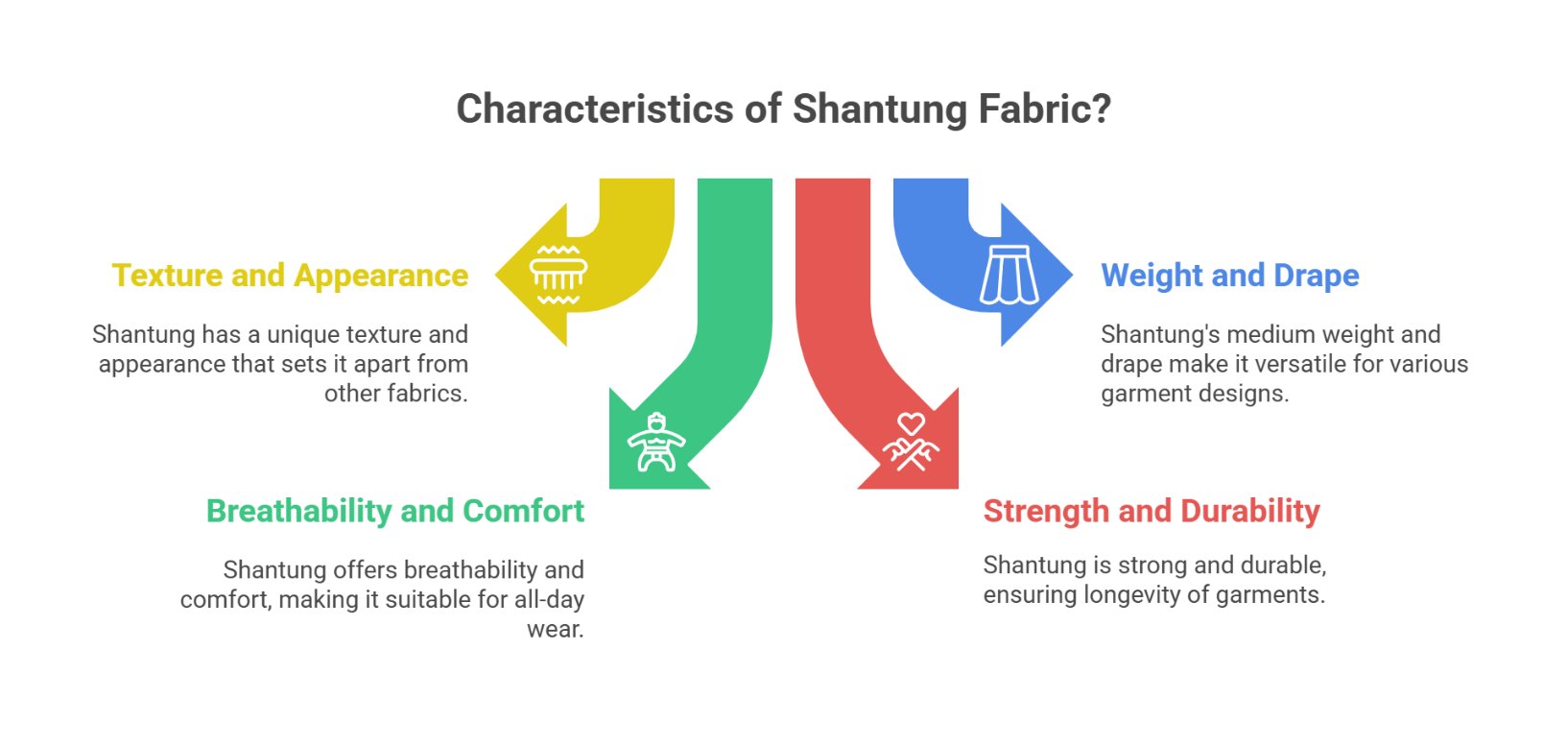
Texture and Appearance
The most distinctive feature of Shantung is its slightly irregular, textured surface. The small slubs create subtle horizontal lines across the fabric, giving it a handwoven, natural appearance. Unlike heavily textured fabrics, Shantung’s slubs are modest enough to work for both structured and flowing designs.
Is shantung fabric shiny? Shantung has a soft, natural sheen rather than a high-gloss shine. The luster is subtle and sophisticated, catching light in a gentle way. It’s shinier than cotton but much less glossy than satin or charmeuse silk.
Weight and Drape
Shantung is a medium-weight fabric that falls somewhere between crisp and flowing. It has enough body to hold structure in garments (great for fitted bodices and A-line skirts) but isn’t stiff or rigid. The fabric drapes elegantly without being too heavy or too light.
This balanced weight makes Shantung highly versatile. You can use it for garments that need to hold their shape, like jackets and structured dresses, or for pieces that should flow gracefully, like evening gowns.
Breathability and Comfort
Is shantung fabric breathable? Yes, natural silk Shantung is highly breathable. Like other silk fabrics, it has temperature-regulating properties that keep you cool in warm weather and provide warmth in cooler conditions. The fabric wicks moisture away from the skin, making it comfortable for all-day wear.
Is shantung breathable? Again, yes for natural silk versions. Polyester Shantung, however, is not as breathable and may feel warm or cause you to sweat in hot weather.
Durability and Strength
Shantung is surprisingly strong for a silk fabric. The tussah silk fibers used in traditional Shantung are naturally tougher and more durable than cultivated mulberry silk. The fabric resists tearing and holds up well to normal wear.
Shantung also resists acids, alkalis, and moderate heat better than many delicate fabrics. It handles sunlight exposure relatively well, though prolonged direct sunlight will eventually fade any fabric.
Wrinkle Resistance
Shantung is relatively wrinkle-resistant compared to other silks, though it’s not completely wrinkle-proof. The crisp nature of the fabric helps it bounce back from minor creasing. It wrinkles less than linen or lightweight silks like crepe de chine.
Color Retention
Shantung holds dye exceptionally well. The colors tend to be rich and long-lasting, especially when the fabric is yarn-dyed. The natural texture of the fabric also adds depth to solid colors, creating visual interest even in simple hues.
Key Benefits of Shantung Silk
- Versatile weight: Works for both structured and flowing designs
- Natural texture: Adds interest without being too casual
- Breathable: Comfortable in various climates (silk versions)
- Durable: Stronger than many other silk types
- Easy to drape: Natural elegance for formal wear
- Rich colors: Takes dye beautifully with long-lasting results
- Relatively low maintenance: Less wrinkle-prone than other silks
Shantung vs Other Fabrics: Understanding the Differences
Knowing how Shantung compares to similar fabrics helps you choose the right material for your project. Let’s look at the key differences between Shantung and other popular fabrics.
Shantung vs Dupioni: What’s the Difference?
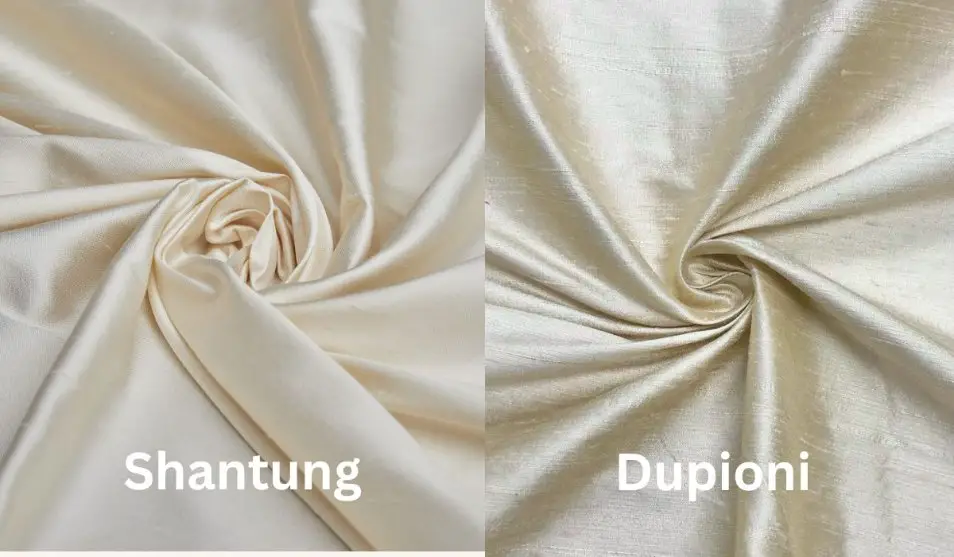
What is the difference between shantung and dupioni? This is one of the most common questions about Shantung. While these fabrics look similar at first glance, there are several key differences:
| Feature | Shantung | Dupioni |
|---|---|---|
| Origin | China (Shandong Province) | Italy (name means “double” in Italian) |
| Slubs | Smaller, more subtle slubs | Larger, more prominent slubs |
| Weight | Lighter, thinner | Heavier, thicker |
| Texture | Smooth with slight texture | More pronounced nubby surface |
| Manufacturing | Machine-woven | Hand-woven |
| Drape | Flows more easily, softer drape | Stiffer, holds shape firmly |
| Iridescence | Usually one color throughout | Often iridescent with two-tone effect |
| Best For | Flowing gowns, draped designs | Structured dresses, full skirts |
Think of it this way: Shantung is like the smooth, refined cousin of Dupioni. It has the texture and character of Dupioni but in a more subtle, elegant form. If Dupioni is a light taffeta, Shantung is the happy medium between Dupioni and smooth charmeuse.
Shantung vs Taffeta
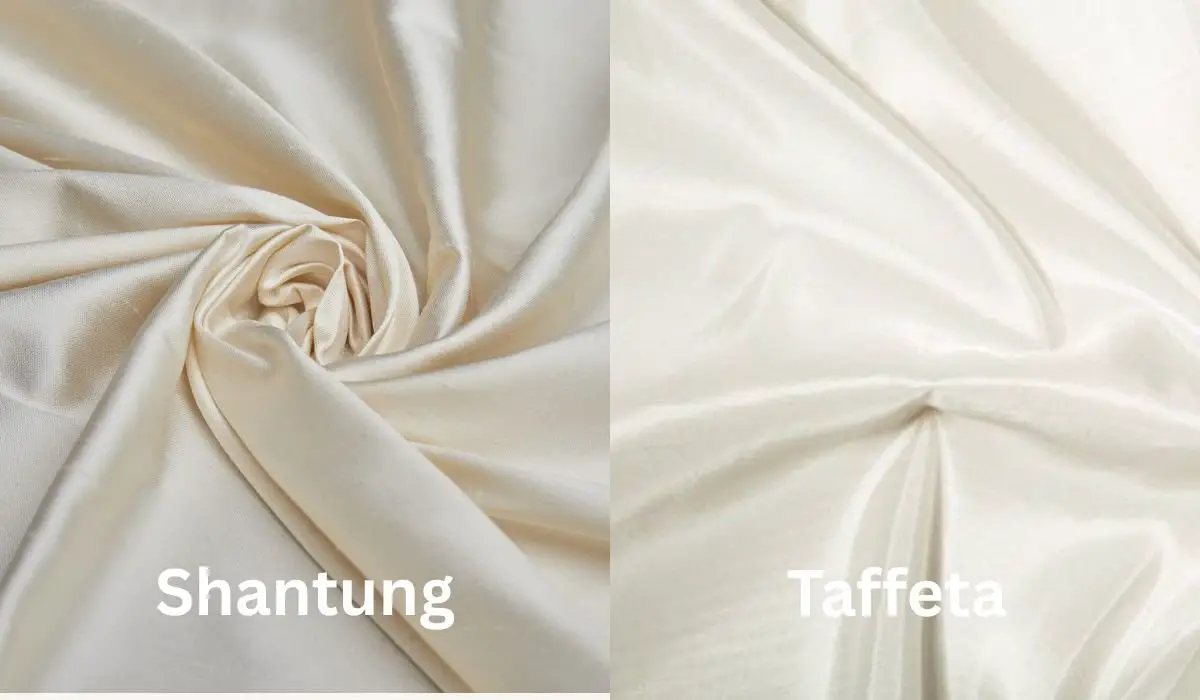
What is a shantung taffeta? Sometimes you’ll hear these terms used together, which can be confusing. Shantung and taffeta are actually separate fabrics, though they share some qualities.
| Feature | Shantung | Taffeta |
|---|---|---|
| Surface | Textured with slubs | Completely smooth |
| Sheen | Soft, subtle luster | High shine, very glossy |
| Crispness | Moderately crisp | Very crisp and stiff |
| Sound | Quiet | Makes a rustling sound |
| Best For | Elegant draping with structure | Ball gowns, voluminous designs |
Shantung sits between Dupioni and taffeta in terms of stiffness. It’s crisper than charmeuse but softer than taffeta.
Shantung vs Charmeuse

| Feature | Shantung | Charmeuse |
|---|---|---|
| Texture | Textured with slubs | Smooth and silky |
| Sheen | Subtle, matte-ish | High gloss, very shiny |
| Drape | Structured, holds shape | Fluid, flows easily |
| Weight | Medium weight | Lightweight |
| Best For | Structured formal wear | Flowing evening gowns, lingerie |
Shantung vs Organza
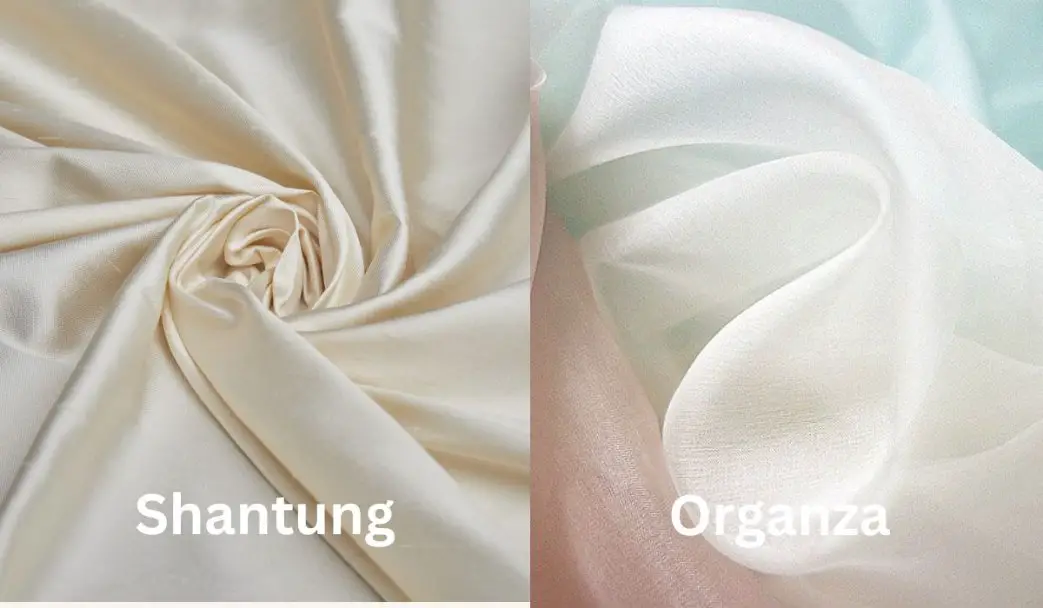
| Feature | Shantung | Organza |
|---|---|---|
| Transparency | Opaque | Sheer, see-through |
| Weight | Medium weight | Very lightweight |
| Crispness | Moderately crisp | Very crisp and stiff |
| Best For | Main garment fabric | Overlays, veils, accents |
Learn more about organza fabric in our detailed guide.
Shantung vs Cotton

| Feature | Shantung | Cotton |
|---|---|---|
| Sheen | Natural soft luster | Matte finish |
| Feel | Smooth, cool | Soft, warm |
| Breathability | Excellent | Excellent |
| Price | Higher | Lower |
| Best For | Formal occasions | Everyday wear |
What Fabrics are Similar to Shantung?
If you’re looking for alternatives to Shantung, consider these similar fabrics:
- Dupioni: The closest match with larger slubs
- Pongee: A simple plain weave silk with a similar slubbed look
- Raw silk: Textured silk with a natural, organic appearance
- Tussah silk fabric: Made from the same wild silk but may have different weave patterns
- Linen: If you want texture in a more casual fabric (check out our Irish linen guide)
The Tussah Silk Connection: Wild Silk vs Cultivated Silk
To truly understand Shantung, you need to know about tussah silk, the wild silk that gives this fabric its unique character.
What is Tussah Silk?
Tussah silk (also called tussar, tassar, or wild silk) comes from silkworms that feed on oak, juniper, and other leaves instead of mulberry leaves. These silkworms often live in wild or semi-wild conditions in forests rather than controlled farm environments.
The most common tussah silkworm is Antheraea pernyi in China and Antheraea mylitta in India. These caterpillars are hardier than their domesticated cousins and can survive in natural environments with less human intervention.
Tussah vs Mulberry Silk
| Feature | Tussah (Wild) Silk | Mulberry (Cultivated) Silk |
|---|---|---|
| Source | Wild or semi-wild silkworms | Domesticated silkworms |
| Diet | Oak, juniper, other leaves | Mulberry leaves only |
| Fiber Length | Shorter, irregular | Long, uniform |
| Texture | Rough, with natural slubs | Smooth, even |
| Color | Natural tan, beige, gray | Natural white, cream |
| Strength | Stronger, more durable | Strong but more delicate |
| Luster | Soft, subtle sheen | High shine, glossy |
Why Tussah Creates Shantung’s Texture
The irregular nature of tussah silk directly creates Shantung’s signature look. Because wild silkworms live in less controlled conditions, their cocoons and the resulting fibers are naturally uneven. When these fibers are spun into yarn, they retain some of these irregularities, forming the slubs that give Shantung its texture.
The natural tan or beige color of tussah silk also means Shantung is easier to dye than some white silks, and the earth tones can be beautiful left natural.
Sustainability and Environmental Impact

As more people care about where their clothes come from, understanding Shantung’s environmental impact becomes important.
Environmental Benefits of Silk Shantung
Environmental Pros
- Biodegradable: Natural silk breaks down completely
- No pesticides: Silk production typically doesn’t use harmful chemicals
- Low water use: Requires less water than cotton production
- Renewable: Silkworms naturally reproduce
- Wild harvesting: Some tussah silk comes from wild sources with minimal environmental impact
- Plant-based dyes: Many producers use natural dyeing methods
Environmental Concerns
- Silkworm welfare: Traditional production boils cocoons with living pupae inside
- Labor conditions: Some silk production happens in regions with poor worker protections
- Chemical processing: Lower-grade silk may use harsh chemicals in processing
- Water pollution: Boiling and dyeing processes can pollute water if not managed properly
Synthetic Shantung Environmental Impact
Polyester Shantung has different environmental considerations:
Negatives:
- Made from petroleum (non-renewable resource)
- Not biodegradable (sits in landfills for hundreds of years)
- Releases microplastics when washed
- Production creates toxic chemicals and greenhouse gases
Positives:
- No animal products used
- Durable (lasts longer, reducing replacement needs)
- Some recycled polyester options available
Ethical Silk Options
If you want Shantung silk but care about animal welfare, look for:
- Peace silk (Ahimsa silk): Harvested after moths emerge naturally
- Wild-harvested silk: Collected from forest cocoons after moths have left
- Silk Mark certified: Verifies genuine silk and some production standards
- Fair trade certified: Ensures better working conditions for silk workers
Some producers in Shandong and other regions are working on more sustainable practices, including government-sponsored programs for cultural preservation and eco-friendly production.
How to Make Sustainable Choices
- Choose quality over quantity: One well-made silk Shantung garment that lasts years is better than multiple cheap synthetic versions
- Buy from transparent suppliers: Ask about production methods and worker conditions
- Care for your Shantung properly: Good maintenance extends fabric life (see our silk care guide)
- Consider secondhand: Vintage silk Shantung garments can be beautiful and eco-friendly
- Support ethical certifications: Look for verified organic, fair trade, or peace silk labels
Uses and Applications: What to Make with Shantung

Shantung’s unique combination of structure and elegance makes it perfect for many different projects.
Wedding and Bridal Fashion
Shantung is one of the most popular fabrics for wedding gowns. Its crisp structure helps create beautiful silhouettes while maintaining an elegant drape. The subtle texture adds visual interest without competing with embellishments or lace overlays.
Perfect for:
- A-line wedding gowns
- Ball gown skirts
- Fitted bodices
- Bridesmaid dresses
- Bridal sashes and belts
- Mother of the bride/groom dresses
- Flower girl dresses
The fabric holds its shape beautifully throughout a long wedding day and photographs well with its subtle sheen.
Learn to draft and sew a metallic shantung bodice with puff sleeves and peplum
Evening and Formal Wear
Shantung’s natural elegance makes it perfect for formal occasions:
- Evening gowns: The fabric drapes beautifully for flowing designs
- Cocktail dresses: Holds structure while remaining sophisticated
- Formal separates: Skirts, blouses, and jackets
- Prom dresses: Creates stunning silhouettes
- Evening wraps and stoles: Adds elegance to any outfit
Menswear
Shantung has a long history in men’s formal wear:
- Shantung ties: The texture and sheen create a refined look perfect for business or formal events
- Dress shirts: Lightweight and breathable for warm weather
- Vests and waistcoats: Adds texture to formal attire
- Suit jackets: Creates elegant summer suits
- Pocket squares: A subtle way to add luxury
When to wear a shantung tie? Shantung ties are perfect for business meetings, weddings, formal dinners, and any occasion where you want a refined but not overly flashy look. The subtle texture adds interest while remaining professional. They’re particularly good for warm weather events because of the breathable silk.
Everyday Fashion
What to make with silk shantung? Beyond formal wear, Shantung works beautifully for:
- Blouses and tops: The crisp texture creates polished everyday looks
- Skirts: A-line or pencil styles that hold their shape
- Dresses: From casual sundresses to office-appropriate sheaths
- Jackets and blazers: Structured but lightweight outerwear
- Pants and trousers: Elegant alternative to cotton or polyester
Accessories
Shantung’s durability makes it good for accessories that need to hold their shape:
- Handbags and clutches: The fabric’s body creates structured bags
- Shoes: Elegant for special occasions
- Hair accessories: Bows, headbands, and scrunchies
- Belts and sashes: Adds texture to outfits
What is a shantung hat? A shantung hat is typically a Panama-style or summer hat woven from silk shantung or a synthetic version. The fabric’s crisp texture and breathability make it excellent for warm weather hats. These hats often have a slightly textured appearance that adds visual interest.
Home Decor
Shantung brings elegance to interior design:
- Curtains and drapes: The fabric’s weight creates beautiful folds
- Cushion covers: Adds luxury to living spaces
- Table linens: Runners, napkins, and placemats for special occasions
- Decorative pillows: The texture adds visual interest
- Upholstery: For accent chairs or headboards (best for low-traffic areas)
- Lampshades: The fabric’s translucence creates beautiful lighting effects
Crafts and Special Projects
- Quilting: Adds texture and luxury to textile art
- Embroidery backing: The firm weave supports detailed work
- Costume design: Period costumes and theatrical wear
- Fabric flowers: The fabric holds shape for realistic blooms
Complete Care Instructions for Shantung Fabric
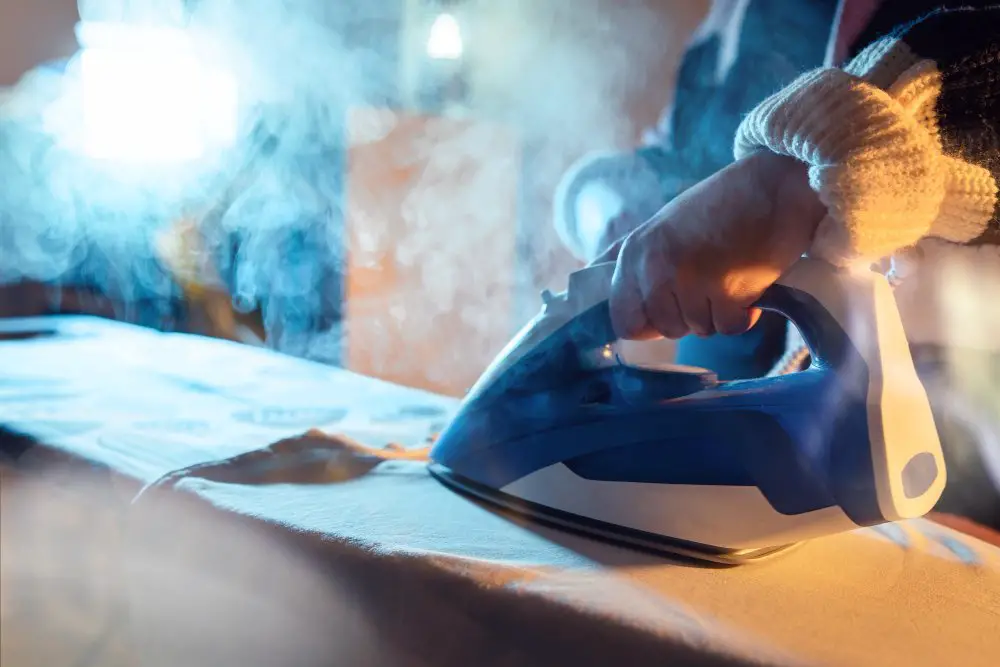
Proper care keeps your Shantung fabric looking beautiful for years. The care method depends on whether you have silk or synthetic Shantung.
Can You Wash Shantung Silk?
Is shantung silk washable? Yes, but with caution. While many people automatically take silk to the dry cleaner, silk Shantung can be hand washed or carefully machine washed. However, washing will change the fabric’s appearance somewhat:
- The sheen may become slightly less pronounced
- The fabric may soften and lose some crispness
- Colors may fade slightly (especially with repeated washing)
- Some shrinkage may occur (usually 2-5%)
For more detailed silk washing instructions, check our comprehensive silk care guide.
Hand Washing Silk Shantung (Recommended)
- Fill a basin: Use cool or lukewarm water (never hot – aim for 85-95°F or 30°C)
- Add detergent: Use a gentle detergent made for delicates or silk. Regular detergents are too harsh. You can also use baby shampoo in a pinch
- Submerge the fabric: Gently place the Shantung item in the water. Don’t bunch it up
- Soak briefly: Let it sit for 3-5 minutes maximum. Don’t soak longer
- Gentle agitation: Swish the fabric gently through the water. Never scrub, twist, or wring silk
- Rinse thoroughly: Use cool water to rinse until all soap is removed. Soap residue can damage silk over time
- Remove water: Roll the fabric in a clean towel and press gently to absorb excess water. Never twist or wring
Machine Washing Silk Shantung
This is riskier but possible for durable silk Shantung:
- Use a mesh bag: Place the item in a large mesh laundry bag
- Select delicate cycle: Choose the gentlest, shortest cycle available
- Cold water only: Never use warm or hot water
- Gentle detergent: Use detergent specifically for delicates
- Skip the spin: If possible, stop the machine before the spin cycle
- Remove immediately: Don’t let wet silk sit in the machine
- Garments with linings in different colors
- Items with beading, sequins, or trims
- Printed Shantung (colors may run)
- Very bright or very dark colors
- Vintage or delicate pieces
Washing Polyester Shantung
Synthetic Shantung is much easier to care for:
- Machine washable: Use warm water and regular detergent
- Tumble dry low: Or hang to dry
- Iron if needed: Use medium heat with a pressing cloth
- More durable: Can handle more frequent washing than silk
Drying Shantung Fabric
For silk Shantung:
- Never use a dryer: High heat will damage or shrink silk
- Hang or lay flat: Use a padded hanger (not wood, which can stain) or lay flat on a clean towel
- Avoid direct sunlight: UV rays can fade colors and weaken fibers
- Air dry in a cool place: Keep away from heat sources
- Dry away from moisture: Don’t dry in humid bathrooms
For polyester Shantung:
- Can use a dryer on low heat
- Air drying still recommended to maintain texture
- Remove promptly to prevent wrinkles
Ironing and Pressing
For silk Shantung:
- Iron while slightly damp: If completely dry, use a spray bottle to mist lightly
- Low to medium heat: Set iron to “silk” setting (usually around 300°F/150°C)
- Use a pressing cloth: Place a clean white cloth or towel between iron and fabric
- Iron on wrong side: This protects the fabric’s sheen
- Never use steam directly: Water spots can stain silk. Use a pressing cloth if steaming
- Keep moving: Don’t let the iron sit in one spot
For polyester Shantung:
- Use medium heat
- Steam is usually safe
- Can iron on either side
- Be careful not to melt with excessive heat
Dry Cleaning
When to dry clean:
- Always dry clean: Garments with linings, complex construction, or mixed fabrics
- Highly recommended: Items for important occasions that must look perfect
- Safe option: If you’re unsure or uncomfortable washing at home
- Printed fabrics: Dry cleaning protects colors from running
When taking Shantung to the dry cleaner, always tell them it’s silk (or polyester) so they use the appropriate solvents and heat settings.
Stain Removal
Act quickly when stains happen:
- Blot immediately: Don’t rub. Use a clean white cloth to blot up liquid
- Test first: Test any cleaning product on a hidden area first
- Use cool water: Dab gently with cool water for fresh stains
- Gentle soap: If needed, use a tiny amount of gentle detergent diluted in water
- Rinse well: Remove all soap to prevent rings
- Professional help: For oil-based stains or set-in marks, take to a professional cleaner
Storage
Proper storage protects Shantung fabric between uses:
- Clean before storing: Never store soiled items. Stains set over time
- Use breathable garment bags: Cotton or muslin bags protect from dust while allowing air circulation
- Avoid plastic: Plastic can trap moisture and cause yellowing
- Padded hangers: Prevent shoulder bumps and creases
- Cool, dry, dark place: Store away from direct light and heat
- Cedar or lavender: Natural moth repellents (never use mothballs on silk)
- Fold carefully: If folding, use acid-free tissue paper between folds
Preventing Damage
- Avoid perfume and hairspray: Chemicals can damage silk
- Apply deodorant first: Let it dry before dressing
- Remove jewelry: Catches and snags can damage the fabric
- Rotate items: Don’t wear the same piece constantly
- Air out after wearing: Hang for a few hours before storing
Buying Guide: How to Choose Quality Shantung Fabric

Is Shantung Fabric Expensive?
Is shantung silk expensive? Yes and no. The price depends on several factors:
| Type | Price Range (per yard) | What Affects Price |
|---|---|---|
| Polyester Shantung | $5-$15 | Quality of synthetic fiber, weave density |
| Blended Shantung | $15-$40 | Percentage of silk, fiber quality |
| Standard Silk Shantung | $30-$60 | Silk quality, weave technique |
| Premium Silk Shantung | $60-$100+ | Artisan production, ethical sourcing, Italian weaving |
High-quality silk Shantung is expensive because:
- Silk production is labor-intensive
- Tussah silk comes from wild or semi-wild sources
- The fabric requires skilled weaving
- It’s a natural, renewable fiber
- The result is durable and long-lasting
How to Identify Quality Shantung
For silk Shantung:
- Look at the label: Should say “100% silk” or “100% tussah silk”
- Check the hand feel: Real silk feels cool to the touch and smooth (despite the slubs)
- Examine the slubs: Should be irregular but not excessive. Too many large slubs indicate lower quality
- Test the sheen: Natural silk has a soft, subtle luster. Synthetic shine looks artificial
- Weight matters: Quality Shantung has a good weight. Very thin fabric may not be true Shantung
- Burn test (if possible): Silk smells like burning hair and turns to ash. Polyester melts and smells like chemicals
- Price check: Very cheap “silk” is probably synthetic
For polyester Shantung:
- Check the weave: Should be tight and even
- Look for fraying: Quality synthetics have clean, sealed edges
- Test the drape: Should have some body, not limp or overly stiff
- Check color: Should be even throughout
Where to Buy Shantung Fabric
Specialty fabric stores:
- See and feel fabric in person
- Get expert advice
- May have limited color selection
Online retailers:
- Wider selection
- Often better prices
- Can’t touch before buying
- Request swatches when possible
Direct from producers:
- Best for wholesale or large quantities
- May require minimum orders
- Often better prices for bulk
What to Look For
- Certification: Look for Silk Mark or similar certifications
- Origin: Authentic Shantung from Shandong, China, or quality silk from Italy
- Return policy: Important for online purchases
- Color consistency: Ask if dye lots vary
- Width: Standard is 54″ wide, but check
- Ethical sourcing: Ask about production methods if this matters to you
Red Flags for Low Quality
- Very cheap price for “silk” (if it seems too good to be true, it probably is)
- Seller can’t provide fiber content details
- No information about origin
- Excessive slubs or very uneven texture
- Artificial-looking shine
- Feels warm rather than cool
- Very thin or flimsy fabric
How Much to Buy
General guidelines:
- Simple dress or blouse: 2-3 yards
- Wedding gown: 5-8 yards (depending on style)
- Formal gown: 4-6 yards
- Pants or skirt: 2-3 yards
- Men’s vest: 1-2 yards
Always buy extra (10-15% more) to account for:
- Pattern matching
- Mistakes
- Shrinkage
- Future repairs
Frequently Asked Questions
Conclusion
After exploring everything from its 4,000-year history in Shandong Province to modern sustainability concerns, it’s clear why shantung fabric has stood the test of time. This unique silk offers a rare combination of elegance, durability, and versatility that few other fabrics can match.
Key Takeaways
What makes shantung special:
- Natural texture from wild silk creates visual interest without being too casual
- Medium weight with structure makes it work for both fitted and flowing designs
- Breathable silk naturally regulates temperature for all-day comfort
- More durable than many other silk types while maintaining elegance
- Subtle sheen adds sophistication without excessive shine
Choosing the right type:
- Pick silk shantung for high-end projects, wedding gowns, formal wear, and items where breathability and natural luxury matter
- Choose polyester shantung for budget-friendly projects, costumes, frequently washed items, or when animal-free materials are preferred
- Consider blends for everyday wear that needs to balance luxury with practicality
Care considerations:
- Silk shantung can be hand washed with care, though dry cleaning is safest for special garments
- Washing will soften the fabric and reduce its crispness
- Proper storage extends the life of your shantung pieces significantly
- The fabric is relatively low-maintenance compared to other silks
Best uses:
- Wedding and formal wear where structure and elegance are needed
- Summer clothing that needs to be breathable yet polished
- Home decor items like curtains and cushions that benefit from the fabric’s weight
- Accessories like ties and hats that need to hold their shape
Making Smart Decisions
Whether you’re buying fabric for a special project or shopping for a shantung garment, remember these shopping tips:
- Know what you’re getting: Check labels carefully. Real silk and polyester versions serve different purposes
- Buy from reputable sources: Quality varies widely, especially with silk
- Consider your project needs: Match the fabric type to how you’ll use and care for the finished item
- Factor in sustainability: If this matters to you, look for peace silk, fair trade, or ethical certifications
- Invest in quality: One well-made silk shantung piece will outlast several cheap synthetics
The Future of Shantung
As fashion moves toward sustainability and quality over quantity, shantung’s natural durability and timeless appeal position it well for the future. Producers in Shandong and elsewhere are working on more eco-friendly production methods, including:
- Peace silk practices that don’t harm silkworms
- Plant-based natural dyes
- Support for traditional weaving communities
- Transparency in supply chains
Meanwhile, the fabric continues to appear on runways and in bridal collections, proving that classic elegance never goes out of style.
Your Next Steps
Now that you understand shantung fabric, here’s what to do next:
- Start small: If you’re new to working with shantung, begin with a simple project like a blouse or cushion cover
- Request swatches: Before buying yards of fabric, get samples to see and feel the quality in person
- Learn proper care: Review the care instructions in this guide and bookmark our silk care guide for reference
- Explore related fabrics: Check out our guides on dupioni, habotai, and other silk types to find the perfect fabric for each project
- Join sewing communities: Connect with others who work with silk to share tips and troubleshoot challenges
Final Thoughts
Shantung fabric represents thousands of years of silk tradition combined with modern production techniques. Whether you choose authentic silk from Shandong or a practical polyester version, understanding this fabric’s unique properties helps you make better decisions for your projects.
The fabric’s ability to be both structured and elegant, formal and breathable, traditional and contemporary, explains why it remains a favorite among designers, brides, and home decorators alike. When you invest in quality shantung and care for it properly, you’re not just buying fabric; you’re acquiring a piece of textile history that can last for years to come.
Ready to start your shantung project? Use the tools and information in this guide to choose, purchase, and care for this beautiful fabric with confidence.

